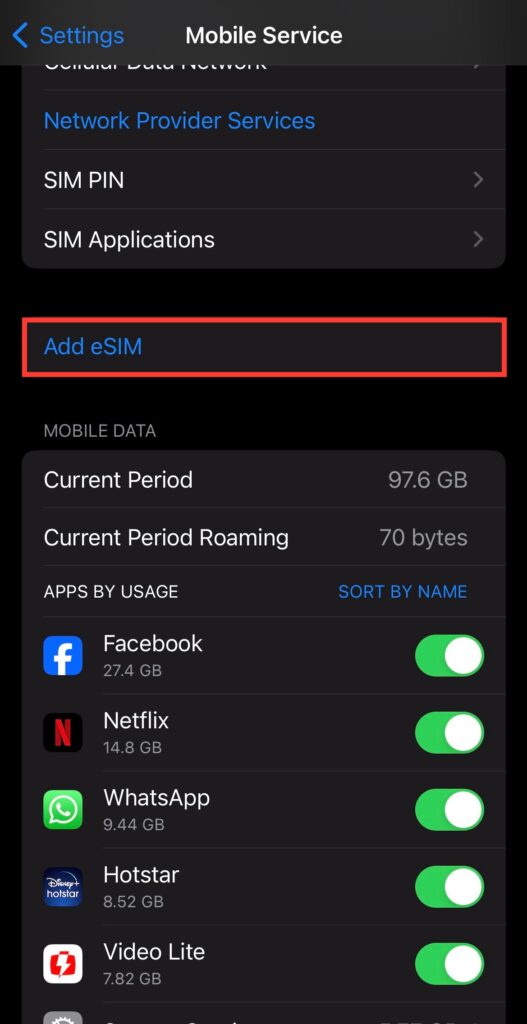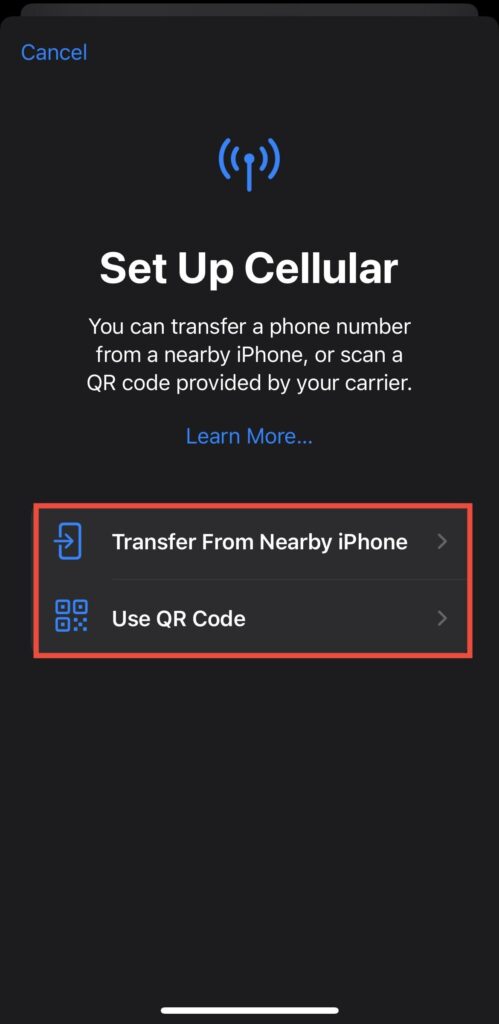Your days of having an actual SIM card are now over. Apple has launched its iPhone 14 models in the U.S. with eSIM only, phasing the physical SIM cards, and we can anticipate the latest models to be the same.
Although eSIM isn’t entirely new, Apple is swimming against the trend of not having an SIM tray on its new iPhones.
The announcement sparked several concerns from users who said it is challenging to utilize the latest phones for travel to developing countries. Apple is now releasing the support documentation detailing different ways to use an eSIM in the new iPhones.
E-SIMs are embedded SIMs that can be programmed. This is a safer method of activating phone carriers because it’s not stolen or misplaced. Also, it eliminates the requirement to purchase, carry around or swap out physical SIM cards. Apple has introduced eSIM on the iPhone X.S. The top Android phones have also had eSIM capability for several years.
Apple permits you to save as many as eight eSIMs. You can also have two SIMs simultaneously (the E-SIM variant with two SIMs). Recently, we discovered that travelling with an electronic SIM (on one of the iPhone X.R. even) is straightforward since various companies provide excellent plans for data and voice services abroad.
The great news to U.S. users is that several of the most reliable providers in the nation have eSIM, which is simple to configure. If you live in the U.S. and just bought yourself the latest iPhone 14, these are the steps to set up eSIM on the device.
What is the process for activating eSIMs?
Apple says it has three types of eSIM support, which differs by the carrier:
eSIM Carrier activation: You can activate a phone with an eSIM associated with the handset.
Fast Transfer eSIM: If you own an iPhone with a number, whether an actual SIM or an eSIM, you can move that phone onto an iPhone’s eSIM. If you have an existing SIM, you can add a process using your smartphone to “convert” it to an electronic SIM.
Alternative methods: Certain carriers might require that you scan a Q.R. code to enable an eSIM or to use an app provided by the carrier. This usually happens for those purchasing pay-as-you-go or a limit-time plan for travel.
The combination of the carrier’s instructions and Apple On-screen help, usually found in Settings > Cellular, guides you through this procedure on your iPhone.
In the tablet, Apple can permanently activate plans for cellular use through Settings > Cellular Data. It’s similar to an electronic SIM. Since the iPad doesn’t use phones, enabling and switching between services is much easier. (Nominally, the carrier will assign an account number to bill, and you cannot utilize it to make text or voice calls.) The eSIM is activated if you sign up for a service on your tablet, either using a QR-code scanner or the carrier’s app, depending on the service you choose.
Apple’s regularly updated list of compatible carriers with eSIMs is featured on the support page.
What is the location of the eSIM setting?
If you’ve got two SIMs connected in any combination, You can manage them via Settings > Cellular or Settings Cellular Data, listed as separate sections within the primary heading. Additionally, you’ll see two rows on the status bar: one for each carrier, which includes the network’s name and the connectivity status for each of them by using the Apple cellular symbols.
When you install apps that can support cellular service using an iPhone, You can choose which plan to utilize for phone and text message calls. You can also decide which plans will carry your data on cellular. Apple offers comprehensive instructions for setting up two lines and determining which method to make calls or for any other reason.
The Mac 911 article answers a question by Macworld reader Steve.
How to Activate eSIM on iPhone 11/12/13 and 14
eSIM information provided by the cell network service provider is required for eSIM. Do not worry; We have provided several methods that can be used in both cases.
Can you activate eSIM on iPhone 13/14?
Yes, you can enable eSIM using iPhone 13 or 14.
Be aware that not all iOS versions have the same options and settings. Make sure that your iPhone is updated with the latest iOS version.
Method 1: eSIM carrier activation during phone setup
Create your eSIM during the activation process for your brand-new iPhone. Here’s how:
It is important to note that this method functions only if a brand-new device is being set up and your existing cellular network has already been converted to an eSIM. Ensure that the Wi-Fi connection is across both mobiles.
- Turn on your iPhone and go through the iPhone settings procedure.
- Make sure you keep your new and old iPhones close to one another.
- Create your iPhone in the usual way, and once you have the mobile networks established, tap the phone number that appears on the display.
- Choose Transfer eSIM in the old mobile to confirm the transfer.
- Double-press the power button on the original handset to confirm your operation.
- Make sure you follow the directions on screen. Be sure to follow the instructions on the screen If there are any.

Method 2: Via Settings
Also, you can enable electronic SIM on your current iPhone. This is done according to the steps below:
- Open Settings and go to Mobile Service.
- Once you have done that, choose the Add eSIM Click.

- Choose Transfer From Nearby iPhone or use a Q.R. Code according to your preference. We’ve chosen to use the Q.R. Code.

- Your provider will supply the code, or you can select a picture from your gallery and click Open Photos.

It is also possible to enter Details Manually and click Next.
The eSIM should now be successfully activated. If you have any doubts, check out our article on How to determine if your eSIM has been started on your iPhone to check the same.
Which iPhones support an eSIM?
The idea of an eSIM card was first introduced in 2000 when Apple introduced the iPhone S.E. iPhone S.E. Following the introduction of the iPhone X.S., XS Max, and X.R.; Apple began supporting electronic SIM cards alongside the conventional SIM card.
However, the iPhone 14 models sold in the United States must include using an actual SIM card and an electronic SIM. With one of the iPhone 13 series devices, you can connect two physical or eSIMs, an eSIM SIM or only one E-SIM.
Shortly, service providers might allow eSIM to be the primary service method. Only one eSIM slot is available to travel internationally in any situation.
It’s reported that the iPhone 14 series reportedly supports the use of up to eight different eSIMs, which can be saved; however, only two are active simultaneously. Apple isn’t announcing anything about the subject, and we need to know if the internationally-based models that are part of the iPhone 14 will feature offline storage for eSIMs alongside their U.S. counterparts.
Multiple SIMs in your pocket can significantly benefit those who frequently travel internationally. People who don’t often travel or frequently can use an eSIM only during their travels, and the service will expire within a specific period.
Use eSIM Carrier Activation on iPhone.
A few carriers and international service providers can provide your iPhone with a new eSIM and simplify setup. It usually occurs after you purchase a service provider-connected iPhone through Apple in the United States or from a carrier and have provided your cellular plan information. If an eSIM was added to the iPhone upon purchase, you should turn off the iPhone and then follow directions to enable your electronic SIM.
Suppose you’re switching to an iPhone (from an Android phone, for example). In that case, you should contact your carrier to move your numbers to the iPhone via eSIM activation for your page or by scanning a Q.R. code provided by the carrier.
If you have contacted your carrier to request an eSIM following the setting up of your iPhone and they have set up eSIM Carrier Activation, follow these instructions:
- Ensure the devices are connected to the identical Apple ID, locked and not in range of each other, with Bluetooth activated, and are running iOS 16 or higher.
- If you see a message which reads Carrier Cellular Plan Ready to Be Installed, tap it.
- Within the Settings app, select Carrier Cellular Plan Ready to Install.
- Tap Continue towards the bottom of the display.
- Call your iPhone to verify its cell connectivity. You should contact your service provider if you cannot make a phone call.
If the plan you activated is equivalent to the one on your physical SIM, then remove the physical SIM. Restart your iPhone.
Conclusion
Enable eSIM on the iPhone 13 opens up a universe of flexibility and convenience. It doesn’t matter if you’re a frequent traveller, an avid digital nomad, or just looking to simplify using your phone using eSIM; it’s an easy solution to store different carriers in your smartphone and change between accounts without needing physical SIM cards. It improves your mobile usage and helps you manage conventional SIM cards. Following the easy instructions below, you can tap the power of eSIM in the iPhone 13 and enjoy the advantages of this revolutionary technology.
Frequently Asked Questions
Do you see any advantages in having eSIMs on your iPhone?
Yes. According to Apple, the iPhone 14 model can store up to eight different SIMs in one go or more, depending on specific cases. Customers can also use two eSIMs in one go, which allows the instant switching of personal and business numbers using an identical device. Travellers who regularly roam abroad don’t have to buy physical SIM cards to switch between numbers.
What is the best way to utilize eSIM to switch between mobile and data carriers using the same phone?
Unfortunately, no. Though most carriers have an eSIM option, the choice to utilize it doesn’t remove any limitations on roaming or changing service providers even after the expiration of the contract. To overcome these limitations, buy an unlocked iPhone initially, then select a provider. Find out more about eSIM by reading the eSIM guide.
Can an eSIM be considered safe for utilization?
It’s easy for thieves to take physical SIM cards. They can be used later to gain access to your personal information, such as texts, contacts, and addresses. An eSIM is considerably more secure than an actual SIM card, as the embedded SIMs can’t be removed or taken. Taking out the SIM PIN from your current SIM to enable the E-SIM is possible.